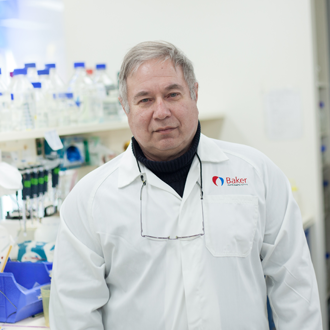About the Lipoproteins and Atherosclerosis laboratory
The current research focus of the laboratory is systemic and cellular lipid metabolism and cardiometabolic complications of infectious diseases.
It is well documented that too much cholesterol in the blood causes many cardiovascular diseases. In order to be able to travel in the bloodstream, cholesterol is combined with protein to form lipoproteins, lipoproteins carry cholesterol throughout the bloodstream. Lipoproteins are carrying cholesterol to and from the vessel wall; if too much cholesterol is carried to and too little is carried from the vessel, it accumulates there. This accumulated cholesterol causes fatty deposits to build up in the vessel wall, this is known as atherosclerosis, the underlying cause of heart attacks. Furthermore, it was recently established that cholesterol inside the cells is a potent regulator of many aspects of cellular metabolism in various tissues and excessive cellular cholesterol causes metabolic dysregulation contributing to the development of many metabolic diseases.
A connection between infectious and cardiovascular diseases has been known for a long time. However, while the mechanisms of contribution of genetic and environmental factors to the burden of cardiovascular disease have been elucidated in great details, the role of infections remains in the shadow. Frequent metabolic and cardiovascular complications of HIV disease re-ignited the interest to the role of infections as a cause of cardiovascular disease. Recent findings that COVID-19 infection causes cardiovascular and/or metabolic sequalae in over 50 per cent of recovered patients make this connection even more important.
Many microbes, but especially viruses, require cholesterol to keep them alive. Microbes can’t make cholesterol themselves, they 'steal' it from the infected organism. To do so, they developed sophisticated tools to 'hijack' cellular cholesterol metabolism and commandeer it to work for their benefits and purposes, which usually do not coincide with the interests of the infected organism. Thus, some microbes force cholesterol to accumulate both in the blood and inside the cells causing development of atherosclerosis and metabolic diseases. Further, microbes force infected cells to release 'signals' to other cells that are not infected coercing them to alter their cholesterol metabolism as well in order to create environment favouring the microbe. Microbes can cause long-term damage to cholesterol metabolism contributing to the risk of cardiometabolic diseases even after successful treatment of the infection eliminated the microbe. On the brighter side, such dependence of microbes on cholesterol creates vulnerability, making cholesterol metabolism a promising therapeutic target to tackle both infectious diseases and their cardiometabolic sequalae. Drugs affecting lipid metabolism, which are so successful in preventing cardiovascular diseases, can be modified to use against infections and their comorbidities. Principles behind these drugs can be used to develop new ways to target infections and metabolic disorders. The research undertaken by Professor Dmitri Sviridov and his team aims to understand and address this problem by investigating the metabolism of cholesterol and the mechanisms responsible for dysregulation of its metabolism in context of infectious, cardiovascular and metabolic diseases.
One of the laboratory’s most significant ongoing projects investigates the development of cardiometabolic comorbidities in people living with HIV. Advanced treatments of HIV have seen infected people living longer lives, and as a result it has become evident that these patients have a higher incidence of heart disease and metabolic complications than other members of the community. It was believed that this higher incidence rate was due to adverse effects of the HIV treatment, as these drugs are known to increase cholesterol in the plasma. However, Professor Sviridov’s group and collaborators found the HIV virus itself modifies cholesterol metabolism to such an extent that cells infected with HIV begin accumulating cholesterol. Moreover, infected cells release 'signals' causing accumulation of cholesterol in non-infected cells as well and affect the blood capacity to receive excess cholesterol from these cells. In addition, it was also found that if the pathway that is causing HIV infected cells to accumulate cholesterol can be controlled, this will not only reduce the development of cardiometabolic comorbidities in the infected person, but will also reduce the activity of the HIV virus. Similar research has been undertaken with two other pathogens, CMV and prions.
Research focus
- Molecular and cellular mechanisms of cholesterol metabolism.
- Regulation of cellular metabolism by 'lipid rafts'.
- Development of new therapeutics to facilitate removal of cholesterol.
- Infections and cardiometabolic diseases.
- Clinical aspects of cholesterol metabolism.
- Lipid metabolism and metabolic diseases.





